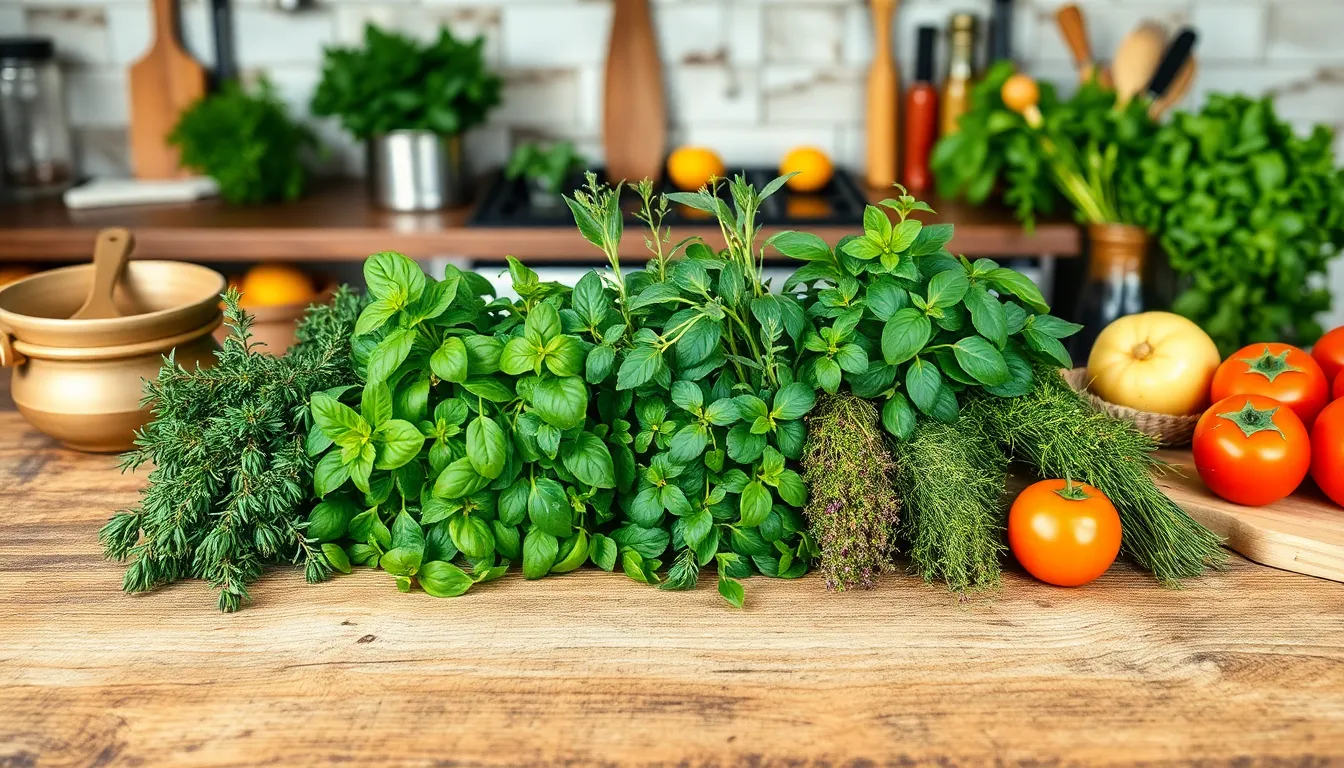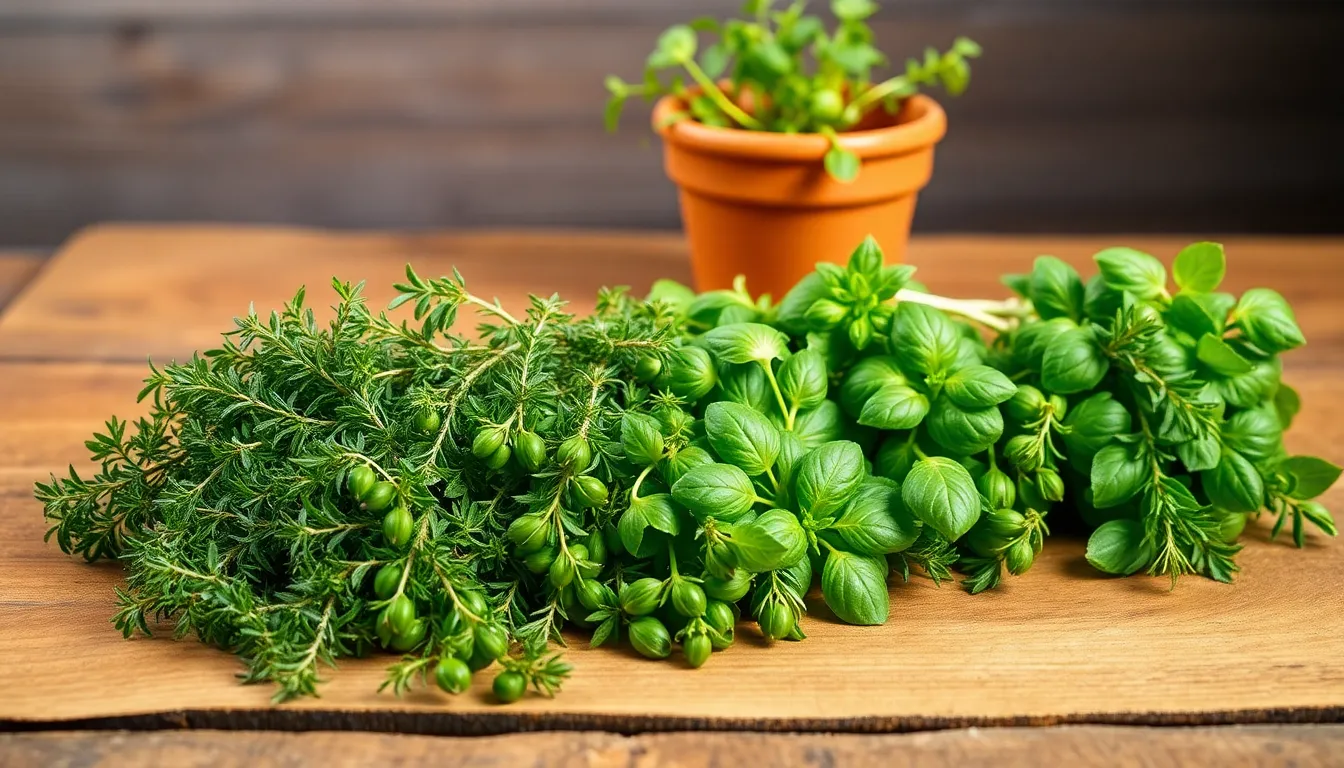When it comes to cooking, French herbs are like the secret agents of flavor—sneaky yet essential. Imagine a world where your dishes are elevated from mundane to magnifique with just a sprinkle of thyme or a dash of tarragon. These aromatic wonders don’t just add taste; they transform meals into culinary masterpieces that even the French would applaud.
French Herbs
French herbs play a key role in enhancing culinary experiences. These ingredients bring depth and complexity to various dishes, making them essential in kitchens around the world. Thyme stands as one of the most versatile herbs, often used in savory recipes. This herb complements meats, vegetables, and soups, providing an earthy flavor.
Tarragon, another significant herb, stands out for its distinctive anise-like taste. Chefs frequently incorporate tarragon in sauces, dressings, and seafood dishes. Basil contributes a fresh, slightly sweet flavor, making it ideal for Mediterranean recipes. Many people use basil in salads and as a garnish for pasta.
Rosemary adds a robust, woody aroma to dishes. Traditionally, it serves well with roasted meats and root vegetables. Oregano, a staple in French cuisine, pairs beautifully with tomato-based dishes, lending a warm, aromatic quality. Chervil, often considered a delicate herb, enhances sauces and soups with its mild, parsley-like flavor.
Sage, known for its strong and slightly peppery profile, complements rich foods. It frequently appears in stuffing and pasta dishes. Culinary experts utilize French herbs not only for flavor but also for health benefits. These herbs contain antioxidants and have anti-inflammatory properties, contributing to overall wellness.
A variety of herbs like dill and parsley show their importance in balancing flavors. Dill adds a refreshing pop to fish dishes, while parsley serves as a bright garnish for many meals. French herbs collectively elevate the sensory experience of cooking, demonstrating their lasting significance in the culinary world.
Popular French Herbs

French herbs play a vital role in enhancing culinary experiences. Each herb brings unique flavors, making them essential in French cuisine.
Herbs de Provence
Herbs de Provence combines several herbs, including thyme, rosemary, and oregano. This herb blend delivers a distinct flavor characteristic of Southern France. Chefs often use it in roasted dishes, stews, and even marinades. The fragrant scent evokes warmth and comfort, making it a favorite for home cooks and professionals alike.
Thyme
Thyme serves as a versatile herb featured in numerous savory dishes. Its earthy, slightly minty flavor complements meats, vegetables, and sauces. As a kitchen staple, thyme contributes depth to stocks and soups. Dried thyme holds its flavor well, making it a reliable choice year-round.
Basil
Basil adds a fresh and slightly sweet essence to many Mediterranean dishes. This aromatic herb shines in pesto, salads, and sauces. Fresh basil leaves contribute vibrant color and flavor, especially in classic Caprese salads. The herb’s fragrance enhances dishes, creating an inviting atmosphere.
Tarragon
Tarragon stands out with its unique anise-like flavor profile. Chefs often use tarragon in French sauces like béarnaise or to elevate seafood dishes. This herb complements chicken and egg dishes brilliantly. Its slightly sweet taste balances savory elements, making it a popular choice in gourmet cooking.
Culinary Uses of French Herbs
French herbs play a crucial role in enhancing the flavor of various dishes. Their unique profiles transform ordinary meals into delightful culinary experiences.
Flavoring Dishes
Thyme stands out for its versatility across savory options. Including thyme in soups, stews, and roasted meats elevates those dishes significantly. Tarragon adds an anise-like taste, enriching sauces and complementing seafood well. Incorporating basil introduces fresh sweetness, perfect for Mediterranean recipes, including pesto and salads. Rosemary’s robust aroma enhances roasted meats and vegetables, creating memorable flavors. Oregano frequently elevates tomato-based dishes, adding depth and warmth. Chervil provides mild hints, making it ideal for sauces and soups that require subtlety. Unique flavor combinations of these herbs consistently enhance overall culinary satisfaction.
Pairing with Ingredients
Pairing French herbs with specific ingredients maximizes their flavor potential. Thyme complements meats like chicken, lamb, and beef, enhancing their natural tastes. Tarragon aligns beautifully with seafood, particularly in light sauces. Basil’s freshness resonates with tomatoes, mozzarella, and other Mediterranean ingredients, delivering vibrant dishes. Rosemary enhances hearty root vegetables and rich meats, creating a comforting balance. Oregano pairs well with both tomatoes and cheeses, especially in Italian cuisine. Chervil blends seamlessly into creamy dressings and sauces, providing lightweight, herbaceous notes. Selecting the right herb transforms a dish, making it more dynamic and enjoyable.
Growing French Herbs
Cultivating French herbs requires understanding their specific needs. Many herbs thrive in well-drained soil, with plenty of sunlight.
Ideal Growing Conditions
Herbs like thyme, tarragon, and basil flourish in full sun, needing at least six hours of direct sunlight daily. A pH level between 6 and 7 works best for most French herbs. Well-draining soil is essential to prevent root rot; mix in compost to enhance nutrients. Regular watering maintains moisture without saturating the soil. Container gardening offers flexibility for those with limited space, allowing easy relocation for optimal sunlight. Maintaining space between plants fosters airflow, reducing the risk of mildew.
Common Growing Challenges
Pests may threaten French herbs, with aphids and spider mites being the most common offenders. Regular inspection ensures timely intervention with organic pesticides when necessary. Overwatering presents another issue; signs like yellowing leaves indicate stressed plants. Avoid poor drainage by using raised beds or pots with drainage holes. Weather extremes pose risks, as high temperatures may require extra watering and shade. Unexpected frosts can damage tender herbs, so cover plants or bring pots indoors during cold snaps.
Conclusion
French herbs are more than just ingredients; they’re the secret to elevating culinary creations. Their unique flavors and aromatic qualities can transform any dish into a memorable experience. From the versatility of thyme to the sweet freshness of basil each herb brings its own character to the table.
Growing these herbs not only enhances meals but also offers a rewarding gardening experience. By understanding their needs and uses aspiring chefs can cultivate a thriving herb garden that enriches both flavor and health. Embracing French herbs in cooking opens the door to a world of taste and creativity that can delight any palate.

